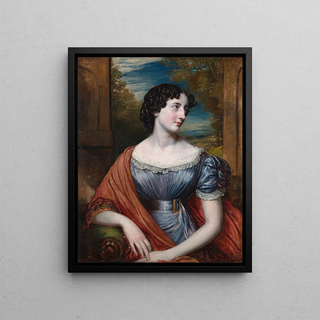Art print | Mademoiselle Jane Puxley - John Linnell


View from behind

Frame (optional)
John Linnell's "Mademoiselle Jane Puxley" is a masterpiece that embodies the elegance and finesse of Victorian portraiture. Created in the 19th century, this canvas depicts a young woman with penetrating eyes, wrapped in a delicate drape that highlights both her beauty and her character. The artwork invites viewers to immerse themselves in a universe where every detail is carefully thought out, revealing not only the appearance of the model but also a certain psychological depth. Linnell, with his undeniable talent, manages to capture the essence of his subject, making this piece timeless and captivating.
Style and uniqueness of the work
Linnell's style is distinguished by his ability to blend realism and romanticism. In "Mademoiselle Jane Puxley," he uses a palette of soft colors, creating an intimate and warm atmosphere. The play of light and shadow, typical of his work, accentuates the delicate features of the young woman while adding an almost sculptural dimension to her face. The meticulous details, such as reflections in her hair and the texture of her clothing, demonstrate exceptional craftsmanship. This portrait is not limited to a simple representation but rises to a level of emotional expression that engages the viewer in deep contemplation. Every glance at this piece reveals a new facet of Jane Puxley's personality, making the observation experience ever-renewing.
The artist and his influence
John Linnell, a British painter of the 19th century, is often associated with the Pre-Raphaelite movement, although he developed a style unique to himself. His career was marked by portraits, landscapes, and biblical scenes, reflecting his versatility and commitment to art. Linnell surrounded himself with influential figures of his time, including members of the Royal Academy and the Pre-Raphaelites, which enriched his artistic vision. His approach to portraiture goes beyond simple representation, seeking to capture the soul of his subjects. "Mademoiselle Jane Puxley" is a perfect example of this quest, where technique and emotion merge seamlessly.

Matte finish

View from behind

Frame (optional)
John Linnell's "Mademoiselle Jane Puxley" is a masterpiece that embodies the elegance and finesse of Victorian portraiture. Created in the 19th century, this canvas depicts a young woman with penetrating eyes, wrapped in a delicate drape that highlights both her beauty and her character. The artwork invites viewers to immerse themselves in a universe where every detail is carefully thought out, revealing not only the appearance of the model but also a certain psychological depth. Linnell, with his undeniable talent, manages to capture the essence of his subject, making this piece timeless and captivating.
Style and uniqueness of the work
Linnell's style is distinguished by his ability to blend realism and romanticism. In "Mademoiselle Jane Puxley," he uses a palette of soft colors, creating an intimate and warm atmosphere. The play of light and shadow, typical of his work, accentuates the delicate features of the young woman while adding an almost sculptural dimension to her face. The meticulous details, such as reflections in her hair and the texture of her clothing, demonstrate exceptional craftsmanship. This portrait is not limited to a simple representation but rises to a level of emotional expression that engages the viewer in deep contemplation. Every glance at this piece reveals a new facet of Jane Puxley's personality, making the observation experience ever-renewing.
The artist and his influence
John Linnell, a British painter of the 19th century, is often associated with the Pre-Raphaelite movement, although he developed a style unique to himself. His career was marked by portraits, landscapes, and biblical scenes, reflecting his versatility and commitment to art. Linnell surrounded himself with influential figures of his time, including members of the Royal Academy and the Pre-Raphaelites, which enriched his artistic vision. His approach to portraiture goes beyond simple representation, seeking to capture the soul of his subjects. "Mademoiselle Jane Puxley" is a perfect example of this quest, where technique and emotion merge seamlessly.






